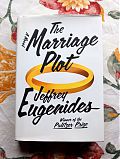
Jeffrey Eugenides
The Marriage Plot
For awhile last November talk of The Marriage Plot was plastered all over bookish websites. And since my library here in Rome got a copy, I checked it out to see what the talk was about. I haven’t read Middlesex, so have nothing to compare Jeffrey Eugenides’ third novel to, which may have been a benefit. The Marriage Plot was for me one of those books I like better when I’m not reading it: the characters, the themes and techniques expand after I’ve set it down and I’m able to admire how good they look from this distance.
My main complaint while reading were the interruptions of progression, how Eugenides’ created the set then exited out the back door to the past in the beginning of every section. This start-stop then re-start, where backstories recrossed the same events from different perspectives, was wearying for me and took me out of the story when I wanted to stay in it. I understood his choice to do this at the start of the novel, catching up to Madeleine’s hang over and bad sex choice, but then the backstories become repetitive—in content and in technique. I craved action straight through, especially when when the backstory wasn’t outside the novel’s time line. Maybe this method came naturally out of telling three characters’ stories and the difficulty of weaving three perspectives together.
But besides from the whiplash, The Marriage Plot succeeds in other ways. In the beginning it’s a book about books and the influence of reading as Leonard, Madeleine and Mitchell finish university. It’s a defense of the Victorian novel and a warning against falling completely for literary trends—but doesn’t discredit the validity—such as Semiotics, popular in the early 80s when the novel takes place. It’s about being in your early 20s when everything seems possible but nothing goes as planned. It’s about love and religion and mental illness.
During Leonard and Madeleine’s break up, Madeleine comforts herself with A Lover’s Discourse by Roland Barthes, a text from her Semiotics course:
If you used your head, if you became aware of how love was culturally constructed and began to see your symptoms as purely mental, if you recognized that being “in love” was only an idea, then you could liberate yourself from its tyranny. Madeleine knew all that. The problem was, it didn’t work. She could read Barthes’ deconstructions of love all day without feeling her love for Leonard diminish the teeniest little bit. The more of A Lover’s Discourse she read, the more in love she felt.
Madeleine’s other course, called The Marriage Plot, is taught by professor Saunders.
In Saunders’s opinion, the novel had reached its apogee with the marriage plot and had never recovered from its disappearance. In the days when success in life had depended on marriage, and marriage had depended on money, novelists had had a subject to write about. The great epics sang of war, the novel of marriage. Sexual equality, good for women, had been bad for the novel. And divorce had undone it completely.
The Marriage Plot defends meaning and feeling, in books as well as in life. It tries to prove that a book, whose center is a “marriage plot,” is not an exhausted form and can exist in our contemporary world where love and marriage don’t have the connotations they once had. At the heart of The Marriage Plot it’s about Mitchell who loves Madeleine who loves Leonard, the old story of the love triangle, told in a new way.
· · · · · · · · · · · · · · · · · · · ·